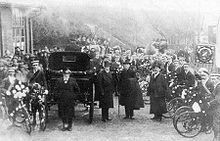Hückelhoven-Baal Station
History

In 1852, was the Aachen–Mönchengladbach line was opened by the former Aachen-Düsseldorf-Ruhrort Railway Company and Baal station was at the 41.6 kilometre point, serving passengers and freight. This station was equipped with an entrance building, a ramp for handling freight, a small turntable and a small transfer table.
The station is still commemorated at its original location by the street named Am Alten Bahnhof (“At the Old Station”) and the retaining wall of its old foundations. Today the Baal freight yard is still located at the site of the old station, along with the dispatcher’s signal box and the junction to the connecting curve to Ratheim, which have not been used since 2007.
The tower station

In 1911, the passenger station was relocated to the west for the opening of the Julich–Dalheim railway. In order to serve the two railways, a “tower station” (Turmbahnhof, that is a station with superimposed platforms on two levels) was built. The line to Dalheim was connected directly by a link at Baal freight yard/Baal West to the Aachen–Mönchengladbach line, which was especially important for freight from the Sophia-Jacoba colliery.
Passenger services between Jülich and Baal were thinned out in the 1960s so that only a few trains remained in the timetable among the many bus services. In addition car-ownership was growing. The consequent decline in ridership prompted Deutsche Bundesbahn to close passenger services between Jülich and Baal on 29 September 1968; freight traffic on this section ended on 28 May 1972. The dismantling of the tracks between Baal and Linnich began in 1974.
The still open line between Baal and Dalheim was initially relatively well used by the population because of the so-called “round service” (Rundverkehr) on the Mönchengladbach–Rheydt–Rheindahlen–Wegberg–Dalheim–Wassenberg–Ratheim–Hückelhoven–Baal (West)–Erkelenz–Rheydt–Mönchengladbach route.
However, in the 1970s, the timetable was thinned to a few trains a day on the northern section from Baal to Dalheim. Eventually the service was abolished and replaced by buses operated by Deutsche Bundesbahn on a route running parallel to the old rail service and the last passenger train ran with a wreath provided by the town of Baal towards Dalheim and Mönchengladbach on 27 September 1980.
Infrastructure
Located at the site of the former tower station there is now only a simple station. The entry signal to the freight yard from the direction of Aachen is located a few metres behind the platform. The station, which is located in the zone of the Aachener Verkehrsverbund (Aachen Transport Association), is used by about 2,000 passengers per day. Because Baal had become part of the municipality of Hückelhoven in 1972, it renamed Hückelhoven-Baal station in 2002. The station needs repairs and is to be rebuilt by the town (including the reactivation of the lift).
On the site of the former low-level station there is a bus top with two bays, which still has a sign with the name of Baal Bahnhof (Baal station), and a parking area.
Rail services
The station is served by the following services:
| Line | Line name | Route | ||
|---|---|---|---|---|
| RE 4 | Wupper-Express | Aachen Hbf – Herzogenrath – Hückelhoven-Baal – Erkelenz – Rheydt Hbf – Mönchengladbach Hbf – Düsseldorf Hbf – Wuppertal Hbf – Hagen Hbf – Witten Hbf – Dortmund Hbf | ||
| RB 33 | Rhein-Niers-Bahn | Aachen Hbf – Herzogenrath – Hückelhoven-Baal – Rheydt Hbf – Mönchengladbach Hbf – Viersen – Krefeld Hbf – Rheinhausen – Duisburg Hbf – Mülheim – Essen | ||
Freight
Until 2007, the freight yard was an important traffic hub despite the closure of the Sophia-Jacoba colliery on 27 March 1997. It continued to be used by Deutsche Bahn coal trains on Mondays and Wednesdays between Baal freight yard and the Ratheim mine train station because SJ-Brikett- und Extracitfabrik GmbH continued to produce briquettes from anthracite at the old colliery site in Hückelhoven. Following the closure of the briquette factory in September 2007, the line between Baal and Ratheim was closed on 1 October 2007. Since then the freight yard has only been used to allow overtaking.
Notes
- ^ "Stationspreisliste 2025" [Station price list 2025] (PDF) (in German). DB Station&Service. 28 November 2024. Retrieved 5 December 2024.
- ^ Eisenbahnatlas Deutschland (German railway atlas) (2009/2010 ed.). Schweers + Wall. 2009. ISBN 978-3-89494-139-0.
- ^ "Liniennetzplan Region Heinsberg" (PDF). Aachener Verkehrsverbund. 1 January 2020. Retrieved 12 June 2020.
- ^ "VRS-Gemeinschaftstarif" (PDF) (in German). Verkehrsverbund Rhein-Sieg. 20 April 2020. p. 201. Archived from the original (PDF) on 11 June 2020. Retrieved 9 May 2020.
- ^ "Hückelhoven-Baal station operations". NRW Rail Archive (in German). André Joost. Retrieved 7 July 2013.
- ^ "History of Baal station" (in German). Retrieved 7 July 2013.
- ^ "Hückelhoven-Baal station". NRW Rail Archive (in German). André Joost. 7 July 2013.
- ^ Stefan von der Ruhren. "Baal-Ratheim line" (in German). Retrieved 7 July 2013.

